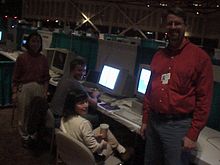- Collaborative software development model
-
The Collaborative software development model is a style of software development whose focus is on public availability and communication, usually via the Internet.The software development model began widespread adoption with the Linux kernel in 1991.
Contents
Collaborative software development and free software
It is the dominant model used in development of free software. It is very compatible with free software because free software projects publish the source code of any published programs, so they do not have the secrecy reason for hiding their communications and in-progress development.
This development model is detailed examined by Eric Raymond in his book The Cathedral and the Bazaar where he compares it to a Bazaar model usually followed by hierarchic organizations.
Peer review
Massive scale peer review of software changes and commits is possible under the collaborative development model. This has been summarised by Raymond in what he terms Linus's Law: many eyeballs make all bugs shallow.
However, the extent that such peer review actually occurs is disputed.[1]
Involving users
One of the key facts is getting users involved. Many organizations have created special programs[2] to ease enrolling new committers.[3]
References
See also

This free software-related article is a stub. You can help Wikipedia by expanding it.

